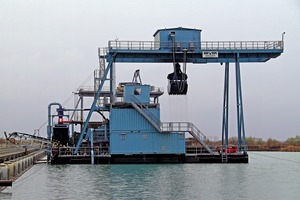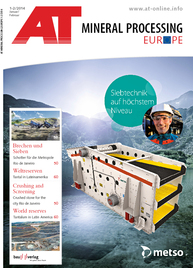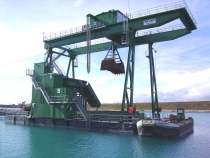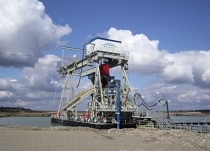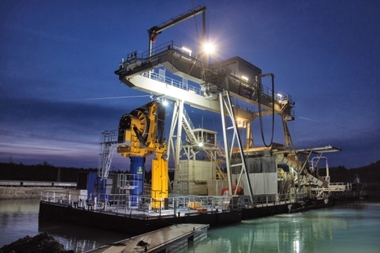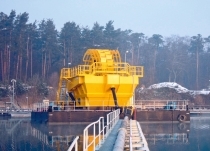Equipped for the next years
Ártándi Kavicsbánya Kft, a company based in Artánd/Hungary, has been running a sand and gravel extraction operation directly on the Romanian border since 1972. After the sand and gravel works had been working with a Mohr MBK 200 grab dredger for almost 40 years, the decision was taken to upgrade the facility to a capacity of 400 t/h, equipping it to handle the high loads of loam and clay impurities as well as the constantly changing material composition depending on the position of the dredger. Moreover, new electric control equipment was to be introduced, which enables an energy saving of over 30 %.
In BEYER, with its representative office BEYER B Hungaria, the company had found the ideal partner for this project. The control systems developed in-house in over 40 years guaranteed optimum tuning of all drives and met the customer’s requirement for dynamic and cost-efficient control of the grab and the trolley. The New Dredger project was not to be just technically optimized for the Artánd gravel works, but also offer an optimally adapted cost-effective solution. So components like the hopper, gantry, chute, tilting grate and belts were built directly at Artánd according to drawings provided by BEYER. In order to guarantee the surveillance of the production Mr. Barabas from BEYER B Hungaria was several times on the ground. Existing assemblies such as motors, gears and grabs were integrated by BEYER in the new concept. The fact that besides the production of these components, Artánd also installed them, so that only the inspection and installation of the electrical and hydraulic assemblies had to be performed by Beyer says a lot about the good cooperation between the partners as well as about the know-how and skill of the Artánd team. On 22.05.2012, a B240 gantry-type dredger with a 7 m3 rope grab could be handed over to the full satisfaction of all involved (Fig.).
The pontoon designed and built by BEYER according to Germanischer Lloyd guidelines is equipped with two Schenck dewatering machines (6 x 2.4 and 4 x 1.5), which ensure very quiet running thanks to their coupled oscillator. The surface of the top deck is adapted to Artánd’s requirements. The surface of the bottom deck allows several variations to adapt to changing conditions. A spray facility for the upper and lower deck and a 6“ vertical pump and 26“ cyclone allow sand processing at a rate of around 150 t/h. The dredger is connected on the discharge side to an existing catamaran belt conveyer. The jib side has mooring winches, which can be installed on the pontoon or the gantry and can be moored either over the deck or the crane runway. The tilting grate and the oversize chute have been adapted to the extraction conditions with the deposits of loam and clay, which can overlie the sand and gravel in up to 6 m3 segments. The overflow of the dewatering screen is either discharged at the side or sent to the dredged material.
A two-drum grab winch with an extra heavy rope grab with 7 m3 supplied by MRS Greifer- und Maschinenbau GmbH ensures steady suspension of the grab and smooth travelling motion. 200 kW A/C squirrel cage motors are controlled with frequency converters from Siemens. The working cycles of the hoisting motors and brakes are tuned to each other in an advanced configuration. The automatic control of the grab cycles takes into account possible regrabbing if the grab is not properly filled, a signal and shut-off of the hoisting motion for protection against large pieces of wood and for draining times that can be individually adjusted. Two pendulum feeders ensure optimum adjustment of the feed of sand and gravel onto the dewatering screen. Many details like the installation of the cables under deck, railing construction with the self-closing doors, the handrails and knee rails closed at the side, the splash guard hooked into the dredging hole, the fender system on the exterior wall of the pontoon for protection against approaching barges and the easy access to the lubrication points are testimony to the over 40 years of experience in building dredgers. “Before, if the dredged material was poor, we had to send it to a buffer stockpile as the processing plant couldn’t keep up with the dredger. Today we can feed the dredged material direct to the plant whether it is good or poor,” reports István David, Operations Manager at Artánd.

